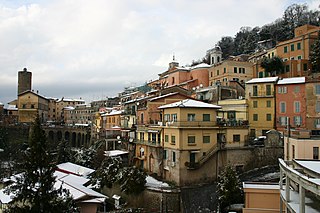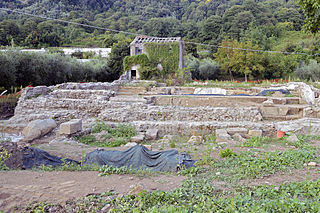History
The temple of Diana Nemorensis was preceded by a sacred grove in which there stood a carved cult image. The temple was noted by Vitruvius as being archaic and "Etruscan" in its form. [4] The cult image still stood as late as 43 BC, when it was reflected in coinage. [5]
Two examples of the
denarius (RRC 486/1) depicting the head of Diana Nemorensis and her triple cult statue
[6] The Italic type of the triform cult image of Diana Nemorensis was reconstructed by Alföldi from a sequence of later Republican period coins he connected with a gens from Aricia. [7] In early examples the three goddesses stand before a sketchily indicated wood, the central goddess placing her right hand on the shoulder of one goddess and her left on the hip of the other. The three are shown to be one by a horizontal bar behind their necks that connects them. Later die-cutters simplified the image. Alföldi interpreted the numismatic image as the Latin Diana "conceived as a threefold unity of the divine huntress, the Moon goddess, and the goddess of the nether world, Hekate," noting that Diana montium custos nemoremque virgo ("keeper of the mountains and virgin of Nemi") is addressed by Horace as diva triformis ("three-form goddess"). [8] Diana is commonly addressed as Trivia by Virgil and Catullus.
The votive offerings, none earlier than the fourth century BC, [9] found in the grove of Aricia portray her as a huntress, and further as blessing men and women with offspring, and granting expectant mothers an easy delivery. [10] The dedicatory inscription, long disappeared, was copied for its curiosity as testimony to the political union of Latin cities, the Latin league [11] by Cato the Elder and transmitted, perhaps incompletely, by the grammarian Priscianus:
Lucum Dianium in nemore Aricino Egerius Baebius Tusculanus dedicavit dictator Latinus. hi populi communiter: Tusculanus, Aricinus, Lanuvinus, Laurens, Coranus, Tiburtis, Pometinus, Ardeatis Rutulus
Diana Nemorensis was not translated to Republican Rome by the rite called evocatio , as was performed for Juno of Veii, but remained a foreigner there, in a temple outside the pomerium , apparently on the Aventine. [12]
A votive inscription of the time of Nerva indicates that Vesta, Roman goddess of the hearth, home, and family, was also venerated in the grove at Nemi. [13]

Diana is a goddess in Roman and Hellenistic religion, primarily considered a patroness of the countryside, hunters, crossroads, and the Moon. She is equated with the Greek goddess Artemis, and absorbed much of Artemis' mythology early in Roman history, including a birth on the island of Delos to parents Jupiter and Latona, and a twin brother, Apollo, though she had an independent origin in Italy.

Venus is a Roman goddess, whose functions encompass love, beauty, desire, sex, fertility, prosperity, and victory. In Roman mythology, she was the ancestor of the Roman people through her son, Aeneas, who survived the fall of Troy and fled to Italy. Julius Caesar claimed her as his ancestor. Venus was central to many religious festivals, and was revered in Roman religion under numerous cult titles.

Vesta is the virgin goddess of the hearth, home, and family in Roman religion. She was rarely depicted in human form, and was more often represented by the fire of her temple in the Forum Romanum. Entry to her temple was permitted only to her priestesses, the Vestal Virgins, who guarded particular sacred objects within, prepared flour and sacred salt for official sacrifices, and tended Vesta's sacred fire at the temple hearth. Their virginity was thought essential to Rome's survival; if found guilty of inchastity, they were buried or entombed alive. As Vesta was considered a guardian of the Roman people, her festival, the Vestalia, was regarded as one of the most important Roman holidays. During the Vestalia privileged matrons walked barefoot through the city to the temple, where they presented food-offerings. Such was Vesta's importance to Roman religion that following the rise of Christianity, hers was one of the last non-Christian cults still active, until it was forcibly disbanded by the Christian emperor Theodosius I in AD 391.

In Sabine and ancient Roman religion and myth, Luna is the divine embodiment of the Moon. She is often presented as the female complement of the Sun, Sol, conceived of as a god. Luna is also sometimes represented as an aspect of the Roman triple goddess, along with Proserpina and Hecate. Luna is not always a distinct goddess, but sometimes rather an epithet that specializes a goddess, since both Diana and Juno are identified as moon goddesses.

The Aventine Hill is one of the Seven Hills on which ancient Rome was built. It belongs to Ripa, the modern twelfth rione, or ward, of Rome.

Lake Nemi is a small circular volcanic lake in the Lazio region of Italy 30 km (19 mi) in the Alban Hills south of Rome. It takes its name from Nemi, the largest town in the area, that overlooks it from a height.

In Greek mythology, Hippolytus is the son of Theseus and either Hippolyta or Antiope. His downfall at the hands of Aphrodite is recounted by the playwright Euripides. Other versions of the story have also survived.

Egeria was a nymph attributed a legendary role in the early history of Rome as a divine consort and counselor of Numa Pompilius, the second king of Rome, to whom she imparted laws and rituals pertaining to ancient Roman religion. Her name is used as an eponym for a female advisor or counselor.

The rex Nemorensis was a priest of the goddess Diana at Aricia in Italy, by the shores of Lake Nemi, where she was known as Diana Nemorensis. The priesthood played a major role in the mythography of James George Frazer in The Golden Bough; his interpretation has exerted a lasting influence.

Nemi is a town and comune in the Metropolitan City of Rome, in the Alban Hills overlooking Lake Nemi, a volcanic crater lake. It is 6 kilometres (4 mi) northwest of Velletri and about 30 kilometres (19 mi) southeast of Rome.
Aricini, the ancient inhabitants of Aricia, the form of the name ranking them with the Sidicini, Marrucini, etc., as one of the communities belonging probably to the earlier or Volscian stratum of population on the west side of Italy, who were absorbed by the Sabine or Latin immigrants.

Ariccia is a town and comune in the Metropolitan City of Rome, central Italy, 25 kilometres (16 mi) southeast of Rome. It is in the Alban Hills of the Lazio (Latium) region and could be considered an extension of Rome's southeastern suburbs. One of the Castelli Romani towns, Ariccia is located in the regional park known as the "Parco Regionale dei Castelli Romani".
A triple deity is a deity with three apparent forms that function as a singular whole. Such deities may sometimes be referred to as threefold, tripled, triplicate, tripartite, triune, triadic, or as a trinity. The number three has a long history of mythical associations and triple deities are common throughout world mythology. Carl Jung considered the arrangement of deities into triplets an archetype in the history of religion.

The Nemi ships were two ships, of different size, built under the reign of the Roman emperor Caligula in the 1st century AD on Lake Nemi. Although the purpose of the ships is speculated upon, the larger ship was an elaborate floating palace, which contained quantities of marble, mosaic floors, heating and plumbing, and amenities such as baths. Both ships featured technology thought to have been developed historically later. It has been stated that the emperor was influenced by the lavish lifestyles of the Hellenistic rulers of Syracuse and Ptolemaic Egypt. Recovered from the lake bed in 1929, the ships were destroyed by fire in 1944 during World War II.

The Nemoralia is a three-day festival originally celebrated by the ancient Romans on the Ides of August in honor of the goddess Diana. Although the Nemoralia was originally celebrated at the Sanctuary of Diana at Lake Nemi, it soon became more widely celebrated. The Catholic Church may have adapted the Nemoralia as the Feast of the Assumption.

The gens Accoleia, also spelled Acoleia, Acculeia, and Aculeia, was a minor plebeian family at Rome during the latter part of the Republic. Most of what is known of this gens comes from various coins and inscriptions.
Volusia Cornelia, also known as Cornelia Volusia was a Roman woman of Patrician status who lived in the late 1st century. She was the daughter of the senator Quintus Volusius Saturninus, suffect consul in 92. She was born and raised in Rome. Her cognomen Cornelia, she inherited from paternal great-grandmother Cornelia Lentula, the daughter of the consul of 3 BC, Lucius Cornelius Lentulus from the gens Cornelia.
Aricina was an epithet of the Greek goddess Artemis, derived from the town of Aricia in Latium, where she was worshipped.

The Temple of Diana Nemorensis was part of an ancient Italic monumental sanctuary erected around 300 BC and dedicated to the goddess Diana. It was a popular place of worship until the late imperial age.
In Greek mythology, Erinoma or Erinona is a beautiful maiden who attracted the attention of both Zeus and Adonis, as well as the wrath of Hera and Aphrodite. Her story seems to be a local variant of Adonis's myth originating from the island of Cyprus, and survives only in the late works of Servius, a Latin grammarian who lived during the early fifth century AD.


















